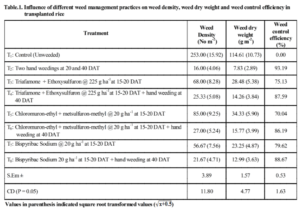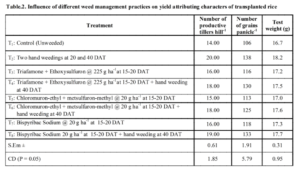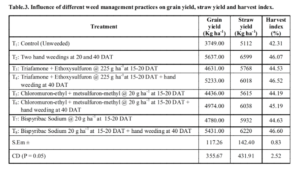EFFECT OFDIFFERENT HERBICIDE COMBINATIONS ON WEED DYNAMICSAND PRODUCTION POTENTIAL OF TRANSPLANTED RICE.
0 Views
M. ASHOK NAIK, P. V. RAMESH BABU, M. SRINIVASA REDDY* AND P. KAVITHA
Department Agronomy, Agricultural College, Mahanandi-518502, ANGRAU, Andhra Pradesh, India.
ABSTRACT
A field experiment was conducted at College Farm, Agricultural College, Mahanandi on sandy loam soils to know the efficacy of different herbicides in transplanted rice. Most of the improved crop management practices in rice cultivation failed in controlling weeds due to poor and improper management. At present the use of herbicides or manual is not effective in timely controlling the weed population. Hence, the present investigation was aimed to study the influence of herbicide in combination with hand weeding on the productivity of transplanted rice. The experiment comprised of 8 treatments i.e. ,such as application of herbicides alone and their integration with one hand weeding, two hand weeding and unweeded check were tested in randomized block design with three replications. Among these treatments, the lower weed density and weed dry weight, higher weed control efficiency, yield attributes, maximum grain yield (5637.00 kg ha-1), straw yield (6599.00 kg ha-1) and harvest index (46.60 %) were recorded under two hand weeding, which was at par with post emergence application of bispyribac sodium 20 g a.i. ha-1 in combination with hand weeding at 40 DAT.
kKEY WORDS:
Transplanted rice, herbicides, hand weeding, weed control efficiency, yield attributes and yield.
INTRODUCTION
Rice [Oryza sativa (L.)] is the most important and extensively grown food crop in India with an area of 44.8 million hectares, production of 104.4 million tones and productivity of 2390 kg ha-1. In Andhra Pradesh, it is grown in an area of 4.51 lakh hectares with a production of 13.77 lakh tonnes and productivity of 2891 kg ha-1 (Anonymous, 2015).The major weed flora observed in transplanted rice are Echinochloa colonum, Echinochloa crus-gall among grasses, Cyperus rotundus, Cyperus difformis, Cyperu siria among sedges and Eclipta alba and Ammania baccifera among broad leaved weeds. However due to increased labour wages and non-availability of labour during peak periods of agricultural operations, timely weeding is not possible besides it is time taking and tedious. Therefore, farmers resorted to increased use of herbicides as it reduces human drudgery and weed management became more efficient and easy in addition to saving of time and being less expensive (Rao et al., 2007). The use of herbicides offers selective, effective and economical control of weeds right from the beginning, giving crop the advantage of good start and competitive superiority. Therefore, there is a need to evaluate new molecules with or without hand weeding to manage the weeds. Hence, the present investigation was undertaken to know the efficiency of different herbicides on weed control efficiency and productivity of transplanted rice.
MATERIALAND METHODS
A field experiment was conducted to study “Efficacy of different herbicides in transplanted rice [Oryza sativa (L.)] in Scarce Rainfall Zone of Andhra Pradesh” under irrigated conditions during kharif, 2017-18 on sandy loam soils of College Farm, Agricultural College, Mahanandi, Andhra Pradesh. The rainfall received during the crop growth period was very meagre i.e. 791.2 mm. The soil of the experimental site was neutral pH (7.91), medium in organic carbon (0.55%),low in N (227 kg ha-1), high in P2O5 (82 kg ha-1) and K2O (1024 kg ha-1). The experi-
ment was laid out in a randomized block design with eight eight treatments and replicated thrice. The treatments consisting of T1: Control (Unweeded), T2: Two hand weedings at 20 and 40 DAT, T3: Triafamone 20 % + Ethoxysulfuron 10 % WP @ 225 g ha-1at 15-20 DAT, T4: Triafamone 20 % + Ethoxysulfuron 10 % WP @ 225 g ha-1at 15-20 DAT + hand weeding at 40 DAT, T5: Chloromuron-ethyl 10 % + metsulfuron-methyl 10 % WP@ 20 g ha-1 at 15-20 DAT, T6: Chloromuron-ethyl 10 % + metsulfuron-methyl 10 % WP @ 20 g ha-1 at 15-20 DAT + hand weeding at 40 DAT, T7: Bispyribac Sodium 10 % SC @ 20g ha-1 at 15-20 DAT, T8: Bispyribac Sodium 10 % SC @ 20 g ha-1at 15-20 DAT + hand weeding at 40 DAT.The fertilizers such as urea, single super phosphate and muriate of potash were used for the supply of NPK and the entire quantity phosphorous applied as basal dose at the time of transplanting and nitrogen and potassium were applied in three equal splits @ basal tillering, panicle initiation and grain filing stage of the crop. The seed rate used for study was 75 kg ha-1with a spacing of 25 x 15 cm. Weed species present in the experimental plot were identified at flowering stage of crop from weedy check plot and grouped as grasses, sedges and broad leaved weeds. The data on weed density and weed dry weight were recorded with the help of a quadrate (0.25 m-2) at four places randomly chosen and then expressed in num-ber per square metre and gram per square metre. The weed control efficiency was worked out on the basis of weed dry matter recorded in each treatment at 30, 60, 90 DAT and at harvest by using the formula suggested by Mani et al. (1973).
DMC – DMT
WCE = ______________________ x 100
DMC
Where,
DMC = Dry matter of weeds in the unweeded check
(control)
DMT = Dry matter of weeds in the treatment imposed
plot.
Values were subjected to square root transformation
( ) prior to statistical analysis to normalize their distribution. Observations on yield attributes and yield of
crop were recorded and statistically analysed.
RESULTSAND DISCUSSION
Weed Flora
During crop growth period, weed flora belonging to eight taxonomic families was observed, of which seven species were grasses, four species were sedges and seven species were broad leaved weeds. The predominant weed species observed were Echinochloa colonum, Echinochloa crus-galli among grasses, Cyperus rotundus, Cyperus difformis, Cyperus iria among sedges and Eclipta alba and Ammania baccifera among broad leaved weeds.
Effect on weeds
All the weed control treatments significantly
reduced weed density, total dry weight of weeds. The lower dry weight of weeds was recorded under two hand weeding at 20 and 40 DAT, which was on par with post-emergence application of bispyribac sodium 20 g a.i. ha-1in combination with hand weeding at 40 DAT. The reduced density and dry weight of weeds might be attributed to broad spectrum and season long weed control by the application of post-emergence herbicides followed by hand weeding. This might be due to effective inhibition of aceto lactate synthase (ALS) enzyme which in turn blocks branched chain amino acid biosynthesis leading to death of weeds. The higher weed density and dry weight was recorded with unweeded check. It means that if weeds were not controlled properly within critical period of crop weed competition, their density continuously remained increasing and affected the crop growth. These results are in line with findings of Singh et al. (2012).The higher weed control efficiency was observed under two hand weeding, which was on par with post emergence application of bispyribac sodium 20 g a.i. ha-1 supplemented with hand weeding at 40 DAT. Similar findings were also reported by Yadav et al. (2009) and Parthipan and Ravi (2016).
Effect on yield attributes and yields of crop
Higher number of productive tillers hill-1, total number of grains panicle-1 and test weight of transplanted rice were significantly influenced by weed control treatments. Maximum number of productive tillers hill-1 was recorded in two hand weeding at 20 and 40 DAT, which was on par with post emergence application of bispyribac sodium 20 g a.i. ha-1in combination with hand weeding at 40 DAT and unweeded check recorded minimum number of productive tillers hill-1. Increase in number of productive tillers hill-1, total number of grains panicle-1, test weight might be due to better environment and ultimate development of large sink created out of reduced crop weed competition. Similar findings were also reported by Survase et al. (2013) and Rishi Raj et al. (2016).
The higher grain and straw yield were observed with two hand weeding over rest of the weed management practices. This might be attributed to reduced competition by weeds due to frequent elimination of weeds from the field that leads to reduced, weed dry weight leading to higher yields. However, the grain yield and straw yield recorded with post emergence application of bispyribac sodium 20 g a.i. ha-1 followed by hand weeding at 40 DAT was comparable with that of two hand weeding. Higher yields under these treatments might be due to increased productive tillers, panicles m-2and grains panicle-1. Similar findings were also confirmatory with the findings of Deepthi Kiran and Subramanyam (2010) and Veeraputhiran and Balasubramanian (2013).The higher harvest index of rice was registered with post-emergence application of bispyribac sodium fb hand weeding at 40 DAT (T8). This might be due to greater translocation of photosynthates from source to sink resulted in higher harvest index under weed control treatments as compared to unweeded check. Similar results were confirmatory with the findings of Uma et al. (2014).
CONCLUSION
From the above results, it can be concluded that
lower weed density, weed dry weight, higher weed control efficiency, higher yield attributes and yield was obtained with two hand weeding at 20 and 40 DAT, however it was on par with the application of bispyribac sodium 20 g a.i. at 20 DAT as post emergence in combination with
hand weeding at 40 DAT and the higher harvest index – 78
was also observed with the same treatment. Over all, it can be concluded that post-emergence application of bispyribac sodium 20 g a.i.ha-1 supplemented with hand weeding at 40 DAT can be recommended for effective weed control and higher productivity of transplanted rice.
REFERENCES
- Anonymous, 2015. Pocket Book of Agricultural Statistics, Directorate of Economics and statistics, New Delhi, 39-49.
- Deepthi Kiran, Y., Subramanyam, D and Sumathi, V. 2010. Growth and yield of transplanted rice (Oryza sativa) as influenced by sequential application of herbicides. Indian Journal of Weed Science. 42 (3&4): 226-228.
- Mani, V. S., Malla, M. L., Gautam, K. C and Bhagavandas 1973. Weed killing chemicals in potato cultivation. Indian Farming. 23:17-18.
- Parthipan, T and Ravi, V. 2016. Productivity of transplanted rice as influenced by weed control methods. African Journal of Agricultural Research. 11(16): 1445-1449.
- Rao, C. P., Venkateswara Rao and Prasad, P. V. N. 2007. Integrated weed management for transplanted rice. Oryza. 44 (2): 166-168.
- Rishi Raj., Anil Kumar., Vikash Kumar., Singh, C.B and Pandey, U.C. 2016. Herbicide options for controlling weeds in transplanted rice (Oryza sativa) under North Eastern Plains Zone. Indian Journal of Agronomy. 61(2): 197-203.
- Singh, A.P., Singh, A.K., Sumit Chaturvedi., Shailender Singh and Mishra, O.P. 2012. Bio-efficacy of sulfonylurea herbicides on mixed weed flora in transplanted rice. Indian Journal of Agricultural Research. 46 (1): 9-15.
- Survase, M. D., Nawlakhe, S. M., Jadhav, S.G., Nayak,S. K and Waghmare, Y. M. 2013. Influence of mechanical and chemical weed management practices on growth and yield of transplanted rice. Journal of Crop and Weed. 9(2):190-192.
- Veeraputhiran, R and Balasubramanian, R. 2013. Evaluation of bispyribac sodium in transplanted rice. Indian Journal of Weed Science.45(1): 12–15.
Uma, G., Venkata Ramana, M., Pratap Kumar Reddy, A and Ram Prakash, T. 2014.Evaluation of low dose herbicides in transplanted rice (Oryza sativa L.).International Journal of Applied Biology and Pharmaceutical Technology.5 (4): 96-101.
Yadav, D.B., Ashok Yadav and Punia, S.S. 2009. Evaluation of bispyribac sodium for weed control in transplanted rice. Indian Journal of Weed Science.41 (1 & 2): 23-27.



- Bio-Formulations for Plant Growth-Promoting Streptomyces SP.
- Brand Preference of Farmers for Maize Seed
- Issues That Consumer Experience Towards Online Food Delivery (Ofd) Services in Tirupati City
- Influence of High Density Planting on Yield Parameters of Super Early and Mid Early Varieties of Redgram (Cajanus Cajan (L.) Millsp.)
- Influence of Iron, Zinc and Supplemental N P K on Yield and Yield Attributes of Dry Direct Sown Rice
- Effect of Soil and Foliar Application of Nutrients on the Performance of Bold Seeded Groundnut (Arachis Hypogaea L.)

